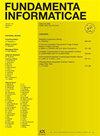元胞自动机、可决性与相位空间
IF 0.4
4区 计算机科学
Q4 COMPUTER SCIENCE, SOFTWARE ENGINEERING
引用次数: 8
摘要
元胞自动机具有丰富的计算特性,同时提供了似是而非的物理计算模型。我们研究了这些自动机相空间中的可决性问题,这些自动机被解释为无限单词的自动结构。在一维,略多于一阶的理论是可判定的,但轨道谓词的加入导致不可判定。我们评论了这种“所见即所得”模式与缺乏自然中间度之间的联系。本文章由计算机程序翻译,如有差异,请以英文原文为准。
Cellular Automata, Decidability and Phasespace
Cellular automata have rich computational properties and, at the same time, provide plausible models of physics-like computation. We study decidability issues in the phasespace of these automata, construed as automatic structures over infinite words. In dimension one, slightly more than the first order theory is decidable but the addition of an orbit predicate results in undecidability. We comment on connections between this “what you see is what you get” model and the lack of natural intermediate degrees.
求助全文
通过发布文献求助,成功后即可免费获取论文全文。
去求助
来源期刊

Fundamenta Informaticae
工程技术-计算机:软件工程
CiteScore
2.00
自引率
0.00%
发文量
61
审稿时长
9.8 months
期刊介绍:
Fundamenta Informaticae is an international journal publishing original research results in all areas of theoretical computer science. Papers are encouraged contributing:
solutions by mathematical methods of problems emerging in computer science
solutions of mathematical problems inspired by computer science.
Topics of interest include (but are not restricted to):
theory of computing,
complexity theory,
algorithms and data structures,
computational aspects of combinatorics and graph theory,
programming language theory,
theoretical aspects of programming languages,
computer-aided verification,
computer science logic,
database theory,
logic programming,
automated deduction,
formal languages and automata theory,
concurrency and distributed computing,
cryptography and security,
theoretical issues in artificial intelligence,
machine learning,
pattern recognition,
algorithmic game theory,
bioinformatics and computational biology,
quantum computing,
probabilistic methods,
algebraic and categorical methods.
 求助内容:
求助内容: 应助结果提醒方式:
应助结果提醒方式:


